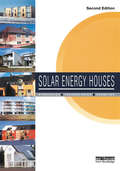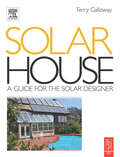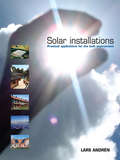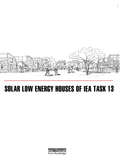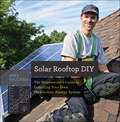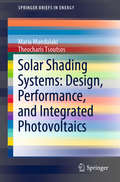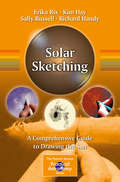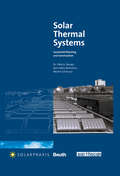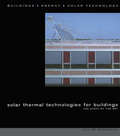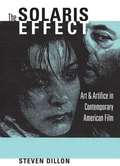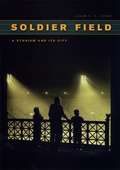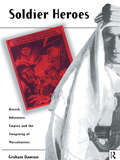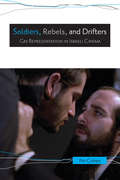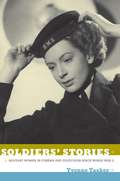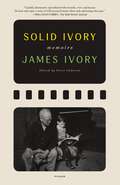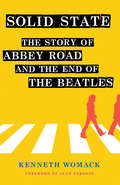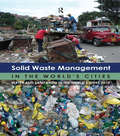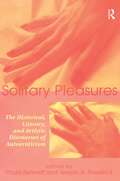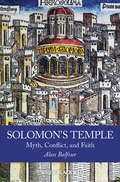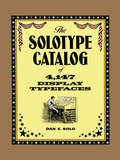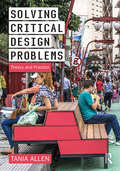- Table View
- List View
Solar Energy Houses: Strategies, Technologies, Examples
by Robert Hastings Anne-Grete Hestnes Bjarne SaxhofPassive and active solar strategies together with the adoption of energy conservation measures and the integration of new materials and technologies can lead to a dramatic reduction of 75-90 per cent in the energy consumption of the buildings. The objective of Task 13 of the IEA's Solar Heating and Cooling Programme was to advance solar building technologies and demonstrate this potential by designing and constructing buildings that met very low energy consumption targets while maintaining a good indoor climate. This revised second edition of this book presents the findings of the Task 13 experts and includes the results of the monitoring programme, conducted to determine the effectives of the techniques and strategies adopted. This new edition also provides a detailed explanation of this research programme in terms of how far the expectations of the Task experts were met and highlights the specific successes and lessons learned from the project.
Solar Home Design Manual for Cool Climates
by Shawna Henderson Don RoscoeIf you want an inexpensive, environmentally sound source of energy for your home, you need look no further than the sun. Solar heat is not subject to rate increases, is totally renewable, pollution free and requires little or no technology. It is here for you today, and can easily provide up to 50% of your space and water heating requirements. This is a book that simply and clearly explains the principles of using solar energy to heat your home. Anyone building a new home, or renovating an old one can incorporate one or several aspects of solar energy into their design. Taking you through the process of designing a solar home from the ground up this manual is also a basic course in conservation and sustainable house design. If you live in a 'heating' climate, meaning if you have space heating requirements for most of the year then this is an invaluable resource. A house is the biggest single investment most of us will make in our lives - the way it is built and how it operates can reflect a long term investment in both the building and the planet.
Solar House: A Guide For The Solar Designer
by Terry GallowayCovering the full life span of the project, from siting issues through specific design features to maintenance of the property and equipment, this is a comprehensive guide to designing, planning and building a solar house. The author uses his experience of living in a solar house to inform the reader of the technology and practices needed for the design, operation and maintenance of the solar home. Each of the technologies of the house, such as space heating and cooling, domestic hot water and electric power technologies, are critiqued from the point of view of the owner/resident, with the author using his thirty years experience of living in a solar home. This provides home owners who are thinking of going solar with first hand evidence of best practice, and provides the architect and designer with the knowledge of how to best satisfy their clients needs.
Solar Installations: Practical Applications for the Built Environment
by Lars AndrenSolar energy will play an important role in our future energy supply, to the advantage of both the environment and the economy. This book focuses on water-based solar heating technology, presenting basic principles on solar radiation and the solar heating system, including details on orientation and output, sizing, the solar collector, the solar circuit, heat exchangers, heat stores and overall system technology. A range of practical applications are described, such as multi- and single-family dwellings, pools, camp sites, sports facilities, schools and industry. The potential and diversity of solar energy is made clear with additional sections on solar electricity, passive solar and solar air heating.
Solar Low Energy Houses of IEA Task 13
by Robert HastingsThe International Energy Agency's Task 13 is to advance solar building technologies. As part of that programme, 15 houses in 12 countries have been built to test new technologies and strategies for achieving low energy demand while maintaining a good indoor climate.;The principal strategies used and evaluated are: minimization of heat losses, profiting from passive solar and internal gains, heating with an active solar system, heating with recovered heat and providing auxiliary heat efficiently.;For each house, this work provides a list of energy features incorporated, an analysis of energy demand, a floor plan, and a description of methods of construction. The houses range from apartment blocks to detached and terraced housing. Local weather conditions, building styles and cultural requirements are taken into consideration.
Solar Rooftop DIY: The Homeowner's Guide to Installing Your Own Photovoltaic Energy System (Countryman Know How)
by Mike SullivanThe do-it-yourself guide for converting your home to solar power Solar energy is clean, efficient, sustainable--and expensive. Or is it? Many homeowners simply assume that the cost of solar panels is out of their reach, but in reality, the technology is quickly becoming attainable for the middle class. Rather than leasing panels from one of those home solar startups (and letting them reap the financial benefits), why not join the thousands who are doing it themselves? In Solar Rooftop DIY, sustainable energy expert Mike Sullivan offers five design plans--ranging from a few simple panels to a complex, roof-covering array--for building a rooftop PV energy system for any home. Each plan has clear and detailed step-by-step photographs showing the installation process. Many of them require no additional labor--just a few days' commitment for the average weekend warrior. With energy costs only set to increase in the future, now is the time to make the switch to solar and start selling power back to the grid.
Solar Shading Systems: Design, Performance, and Integrated Photovoltaics (SpringerBriefs in Energy)
by Maria Mandalaki Theocharis TsoutsosThis is the first book to describe the development of and state of the art in solar shading devices in buildings, detailing all methods of evaluating shading systems according to thermal and visual comfort. The issue of energy balance in buildings is gaining importance as conventional energy sources dwindle and become more expensive. As such, environmental concerns should be considered in overall design decisions. The book discusses the role sun control “machines” play in controlling solar and thermal radiation. It examines their geometry, their position in relation to glazing and their operation (in the cases of movable systems) to control the heat and light entering a building, as well as how their material and color influence their performance. This book appeals to architects and designers who are interested in efficient energy facade design.
Solar Sketching
by Erika Rix Kim Hay Sally Russell Richard HandyFrom the authors of Sketching the Moon comes a comprehensive guide filled with richly illustrated, detailed drawing tutorials that cover a variety of solar phenomena. Explanations of what to expect visually from white light, Hydrogen-alpha and Calcium K filters are provided for those new to solar observing, along with essential tips on equipment, observing techniques and the practicalities of drawing at the eyepiece. Time-honored, traditional methods and media are described in tandem with innovative techniques developed and shared by contemporary astronomical sketchers. For the technically minded, detailed descriptions are given on how to use image manipulation software to bring your sketches to life through animation. The Sun is the most visually dynamic object in our solar system and offers compelling, spectacular views. Knotted magnetic field lines give rise to powerful eruptions and form the intricate sunspots and arching prominences that make our nearest star one of the most exciting, yet challenging, astronomical objects to sketch. Facilitated by the availability of affordable dedicated solar telescopes and filters, the Sun has become an increasingly popular target amongst astronomical sketchers. The use of narrowband solar filters provides a wonderful opportunity to capture views of the Sun that have, until recently, been largely inaccessible. You'll discover easy to follow, step-by-step instructions geared toward your specific interests, be it technical sketching and contributing to science, personal study, or even fun solar outreach activities that help children learn through art. By using Solar Sketching as a reference, drawing the Sun has never been easier.
Solar Thermal Systems: Successful Planning and Construction
by Dr Felix Peuser Karl-Heinz Remmers Martin SchnaussSolar Thermal Systems summarizes the theoretical and practical knowledge gained from over 20 years of research, implementation and operation of thermal solar installations. This work provides answers to a variety of key questions by examining current solar installations, drawing upon past experiences and making proposals for future planning. - how do system components and materials behave under continuous operation? - which components have proven themselves and how are they used properly? - what are the causes of defects and how can they be avoided? - how long is the service life of modern solar installations? - what is the difference between the various solar collectors? - what performance can be expected from solar installations? - how are solar installations planned and structured correctly? In addition to practical recommendations on implementation, the theoretical background is also clearly explained. This book is a valuable guide for all those who deal with solar technology and at the same time a reference for the daily work of planners and fitters. It will also prove a useful tool for training and education.
Solar Thermal Technologies for Buildings: The State of the Art (BEST (Buildings Energy and Solar Technology))
by M. SantamourisSolar thermal is now a proven technology in terms of reliability, cost-benefit, and low environmental impact. The integration of solar thermal systems and installations into the design of buildings can provide a clean, efficient and sustainable low-energy solution for heating and cooling, whilst, taken in a wider context, contributing to climate protection. This book covers the state of the art in the application of solar thermal technologies for buildings. This is the first book in the BEST (Buildings, Energy and Solar Technology) Series. This series presents high-quality theoretical and application-oriented material on solar energy and energy-efficient technologies. Leading international experts cover the strategies and technologies that form the basis of high-performance, sustainable buildings, crucial to enhancing our built and urban environment.
The Solaris Effect: Art and Artifice in Contemporary American Film
by Steven DillonWhat do contemporary American movies and directors have to say about the relationship between nature and art? How do science fiction films like Steven Spielberg's A.I. and Darren Aronofsky's π represent the apparent oppositions between nature and culture, wild and tame?<P><P> Steven Dillon's intriguing new volume surveys American cinema from 1990 to 2002 with substantial descriptions of sixty films, emphasizing small-budget independent American film. Directors studied include Steven Soderbergh, Darren Aronofsky, Todd Haynes, Harmony Korine, and Gus Van Sant, as well as more canonical figures like Martin Scorcese, Robert Altman, David Lynch, and Steven Spielberg. The book takes its title and inspiration from Andrei Tarkovsky's 1972 film Solaris, a science fiction ghost story that relentlessly explores the relationship between the powers of nature and art. The author argues that American film has the best chance of aesthetic success when it acknowledges that a film is actually a film. The best American movies tell an endless ghost story, as they perform the agonizing nearness and distance of the cinematic image.
Solder Technique Studio: Soldering Iron Fundamentals for the Mixed Media Artist
by Giuseppina CirincioneDiscover Soldering Secrets! Whether you've never soldered before or are used to using your soldering iron primarily for stained glass, you will discover a bounteous new world of artistic possibilities in Solder Technique Studio. Workshop instructor, artist and author, Giuseppina "Josie" Cirincione shares in-depth information about everything from materials for soldering and glass cutting to previously unpublished soldering techniques, such as attaching jump rings using two pieces of glass. Follow along with 14 step-by-step projects, such as a wall shelf, an eyeglass pendant, bottle topper, a glass book and so many more! Inside you'll find Thorough soldering and glass cutting techniques, including detailed descriptions of materials with step-by-step photographs. 14 dimensional projects shown step-by-step, and incorporating a variety of mixed-media materials such as previously brewed tea bags, pencils, alcohol inks and much more. Techniques and projects to use beyond mixed-media art, to include stained glass and jewelry work.
Soldier Field: A Stadium and Its City
by Liam T. A. FordSports fans nationwide know Soldier Field as the home of the Chicago Bears. For decades its signature columns provided an iconic backdrop for gridiron matches. But few realize that the stadium has been much more than that. Soldier Field: A Stadium and Its City explores how this amphitheater evolved from a public war memorial into a majestic arena that helped define Chicago. Chicago Tribune staff writer Liam Ford led the reporting on the stadium's controversial 2003 renovation- and simultaneously found himself unearthing a dramatic history. As he tells it, the tale of Soldier Field truly is the story of Chicago, filled with political intrigue and civic pride. Designed by Holabird and Roche, Soldier Field arose through a serendipitous combination of local tax dollars, City Beautiful boosterism, and the machinations of Mayor "Big Bill" Thompson. The result was a stadium that stood at the center of Chicago's political, cultural, and sporting life for nearly sixty years before the arrival of Walter Payton and William "The Refrigerator" Perry. Ford describes it all in the voice of a seasoned reporter: the high school football games, track and field contests, rodeos, and even NASCAR races. Photographs, including many from the Chicago Park District's own collections, capture these remarkable scenes: the swelling crowds at ethnic festivals, Catholic masses, and political rallies. Few remember that Soldier Field hosted Billy Graham and Martin Luther King Jr., Judy Garland and Johnny Cash--as well as Grateful Dead's final show. Now part of the city's bid for the 2016 Olympic Games, Chicago's stadium on the lake continues to make dramatic history. Soldier Field captures this history in the making and will captivate armchair historians and sports fans alike.
Soldier Heroes: British Adventure, Empire and the Imagining of Masculinities
by Graham DawsonSoldier Heroes explores the imagining of masculinities within adventure stories. Drawing on literary theory, cultural materialism and Kleinian psychoanalysis, it analyses modern British adventure heroes as historical forms of masculinity originating in the era of nineteenth-century popular imperialism, traces their subsequent transformations and examines the way these identities are internalized and lived by men and boys.
Soldiers, Rebels, and Drifters: Gay Representation in Israeli Cinema
by Nir CohenA cultural history of gay filmmaking in Israel that explores its role in the rise of gay consciousness over the past three decades.
A Soldier's Sketchbook: The Illustrated First World War Diary of R.H. Rabjohn
by John WilsonA unique First World War diary, illustrated with more than a hundred stunning pencil sketches, for children learning history and also for adults interested in a new perspective on the War and authentic wartime artefacts.Russell Rabjohn was just eighteen years old when he joined up to fight in the First World War. In his three years of soldiering, he experienced the highs and lows of army life, from a carefree leave in Paris to the anguish of seeing friends die around him. Like many soldiers, he defied army regulations and recorded everything he saw and felt in a small pocket diary. Private Rabjohn was a trained artist, and as such he was assigned to draw dugouts, map newly captured trenches, and sketch the graves of his fallen comrades. This allowed him to carry an artist's sketchbook on the battlefield--a freedom he put to good use, drawing everything he saw. Here, in vivid detail, are images of the captured pilot of a downed German biplane; the horrific Flanders mud; a German observation balloon exploding in midair; and the jubilant mood in the streets of Belgium when the Armistice is finally signed. With no surviving veterans of the First World War, Rabjohn's drawings are an unmatched visual record of a lost time. Award-winning author John Wilson brings his skills as a historian and researcher to bear, carefully curating the diary to provide context and tell the story of Private Rabjohn's war. He has selected each of the diary entries and the accompanying images, and has provided the background that modern-day readers need to understand what a young soldier went through a century ago. The result is a wonderfully detailed and dramatic account of the war as seen through an artist's eyes.
Soldiers' Stories: Military Women in Cinema and Television Since World War II
by Yvonne TaskerFrom Skirts Ahoy! to M*A*S*H, Private Benjamin, G. I. Jane, and JAG, films and television shows have grappled with the notion that military women are contradictory figures, unable to be both effective soldiers and appropriately feminine. In Soldiers' Stories, Yvonne Tasker traces this perceived paradox across genres including musicals, screwball comedies, and action thrillers. She explains how, during the Second World War, women were portrayed as auxiliaries, temporary necessities of "total war. " Later, nursing, with its connotations of feminine care, offered a solution to the "gender problem. " From the 1940s through the 1970s, musicals, romances, and comedies exploited the humorous potential of the gender role reversal that the military woman was taken to represent. Since the 1970s, female soldiers have appeared most often in thrillers and legal and crime dramas, cast as isolated figures, sometimes victimized and sometimes heroic. Soldiers' Stories is a comprehensive analysis of representations of military women in film and TV since the 1940s. Throughout, Tasker relates female soldiers' provocative presence to contemporaneous political and cultural debates and to the ways that women's labor and bodies are understood and valued.
Solid Ivory: Memoirs
by James IvoryThe irreverent, brilliant memoirs of the legendary filmmaker James IvoryIn Solid Ivory, a carefully crafted mosaic of memories, portraits, and reflections, the Academy Award–winning filmmaker James Ivory, a partner in the legendary Merchant Ivory Productions and the director of A Room with a View, Howards End, Maurice, and The Remains of the Day, tells stories from his remarkable life and career as one of the most influential directors of his time. At times, he touches on his love affairs, looking back coolly and with unexpected frankness.From first meeting his collaborator and life partner, Ismail Merchant, at the Indian Consulate in New York to winning an Academy Award at age eighty-nine for Call Me by Your Name; from seeing his first film at age five in Klamath Falls, Oregon, to memories of Satyajit Ray, Jean Renoir, The New Yorker magazine’s film critic Pauline Kael (his longtime enemy), Vanessa Redgrave, J. D. Salinger, George Cukor, Kenneth Clark, Bruce Chatwin, Ruth Prawer Jhabvala, and Merchant—Ivory writes with invariable fluency, wit, and perception about what made him who he is and how he made the movies for which he is known and loved.Solid Ivory, edited by Peter Cameron, is an utterly winning portrait of an extraordinary life told by an unmatched storyteller.
Solid State: The Story of "Abbey Road" and the End of the Beatles
by Kenneth WomackAcclaimed Beatles historian Kenneth Womack offers the most definitive account yet of the writing, recording, mixing, and reception of Abbey Road.In February 1969, the Beatles began working on what became their final album together. Abbey Road introduced a number of new techniques and technologies to the Beatles' sound, and included "Come Together," "Something," and "Here Comes the Sun," which all emerged as classics. Womack's colorful retelling of how this landmark album was written and recorded is a treat for fans of the Beatles. Solid State takes readers back to 1969 and into EMI's Abbey Road Studio, which boasted an advanced solid state transistor mixing desk. Womack focuses on the dynamics between John, Paul, George, Ringo, and producer George Martin and his team of engineers, who set aside (for the most part) the tensions and conflicts that had arisen on previous albums to create a work with an innovative (and, among some fans and critics, controversial) studio-bound sound that prominently included the new Moog synthesizer, among other novelties. As Womack shows, Abbey Road was the culmination of the instrumental skills, recording equipment, and artistic vision that the band and George Martin had developed since their early days in the same studio seven years earlier. A testament to the group's creativity and their producer's ingenuity, Solid State is required reading for all fans of the Beatles and the history of rock 'n' roll.
Solid Waste Management in the World's Cities: Water and Sanitation in the World's Cities 2010
by Un-HabitatIn our rapidly urbanizing global society, solid waste management will be a key challenge facing all the world's cities. Solid Waste Management in the World's Cities provides a fresh perspective and new data on one of the biggest issues in urban development. Using the framework of Integrated Sustainable Waste Management (ISWM), the report brings together unprecedented research from 22 cities across six continents. It uncovers the rich diversity of waste management systems that are in place throughout the world, and draws out the practical lessons for policymakers. The volume will be essential reading for all professionals and policymakers in the field, as well as a valuable resource for researchers and students in all aspects of urban development. Winner of the International Solid Waste Association Publication Award 2010 Published with UN-Habitat.
Solid Wood: Case Studies in Mass Timber Architecture, Technology and Design
by Joseph MayoOver the past 10-15 years a renaissance in wood architecture has occurred with the development of new wood building systems and design strategies, elevating wood from a predominantly single-family residential idiom to a rival of concrete and steel construction for a variety of building types, including high rises. This new solid wood architecture offers unparalleled environmental as well as construction and aesthetic benefits, and is of growing importance for professionals and academics involved in green design. Solid Wood provides the first detailed book which allows readers to understand new mass timber/massive wood architecture. It provides: historical context in wood architecture from around the world a strong environmental rationale for the use of wood in buildings recent developments in contemporary fire safety and structural issues insights into building code challenges detailed case studies of new large-scale wood building systems on a country-by-country basis. Case studies from the UK, Norway, Sweden, Germany, Austria, Italy, Canada, the United States, New Zealand and Australia highlight design strategies, construction details and unique cultural attitudes in wood design. The case studies include the most ambitious academic, hospitality, industrial, multi-family, and wood office buildings in the world. With discussions from leading architectural, engineering, and material manufacturing firms in Europe, North America and the South Pacific, Solid Wood disrupts preconceived notions and serves as an indispensable guide to twenty-first century wood architecture and its environmental and cultural benefits.
Solitary Pleasures: The Historical, Literary and Artistic Discourses of Autoeroticism
by Paula Bennett Vernon A. Rosario IISolitary Pleasures is the first anthology to address masturbation, exploring both the history and artistic representation of autoeroticism. Masturbation today enjoys a highly equivocal and contradictory status among cultural discourses relating to sexuality. On the one hand, it is the subject of much popular treatment, especially in sexual self-help books, advice columns, and in pop culture--for example, Madonna's "Like a Virgin" performance, a recent Roseanne episode, and David Russell's movie Spanking the Monkey. On the other hand, masturbation is still a taboo subject for most people in everyday conversation. Perhaps more surprising, it has been largely dismissed by academics as a trivial, humorous topic and the "history of a delusion."It was not until the eighteenth century that "onanism" was portrayed as a morbid act of epidemic proportions that produced pox, hair loss, blindness, insanity, impotence and a horrible. Its prevention and treatment warranted diverse and often cruel measures: surveillance, diets, drugs, corsets, electrical alarms, urethral cauterization, clitoridectomy, and labial sewing. This literature's apocalyptic warnings about the personal and social morbidity of "pollution-by-the-hand" are largely unknown to most people today, but the ghostly echoes of these admonitions still inform and preserve the present taboo of the subject.Why did this apparently innocuous activity become so overpoweringly stigmatized? Why was the eradication of masturbation one of the most important goals of 19th century public hygiene? Why, even after the "sexual revolution," is masturbation still shrouded in shame?
Solomon's Temple: Myth, Conflict, and Faith
by Alan BalfourA highly original architectural history of Solomon’s Temple and Islam’s Dome of the Rock that doubles as a social and cultural history of the region The most extensive study of the interrelated history of two monuments, Solomon’s Temple and The Dome of the Rock, drawing on an exhaustive review of all the visual and textual evidence Relayed as a gripping narrative, allowing readers to re-enter and experience the emotions and the visceral reality of the major events in its history Integrates illustration with the text to offer a highly detailed and accurate portrait of the major structures and figures involved in the history of the temple Opens up a fascinating line of questioning into the conventional interpretation of events, particularly Christ’s actions in the Temple Reproduces rarely seen detailed drawings of the subterranean passages beneath Temple Mount as part of the British survey in the 19th century
The Solotype Catalog of 4,147 Display Typefaces
by Dan X. SoloThe author of many books on typography, Dan X. Solo was also the proprietor of his own typography shop in Oakland, California -- an establishment dedicated to unusual typography and special effects. This comprehensive catalog offers graphic designers a dazzling selection of over 4,000 typefaces and optical effects available from Solotype Typographers.Here, in Solo's words, is "a great cast of characters" -- the alphabet -- abetted by a cornucopia of typographical ideas and an endless resource of letters, words, phrases, slogans, logos, humorous comments, headlines, and graphic symbols. Individual sections of the book display a rich variety of typefaces in categories such as Condensed, Victorian, Art Nouveau, Art Deco, Rustic, Thick-and-tin, Calligraphic, Uncials, Latins, and Blackletter.Samples are imaginatively presented. "Stagecoach," for example, is printed in Fargo typeface, evoking dusty trails, rawhide, and ten-gallon hats, while "Sizzling summer savings" appears appropriately in the flamboyant Firebug typeface. All typefaces are indexed for quick and easy reference. As entertaining as it is practical and useful, this impressive treasury of versatile typefaces and optical effects will be indispensable to busy commercial artists as an inexhaustible source of typographic ideas and a "swipe file" of words, phrases, and letters for use in graphic art projects.
Solving Critical Design Problems: Theory and Practice
by Tania AllenSolving Critical Design Problems demonstrates both how design is increasingly used to solve large, complex, modern-day problems and, as a result, how the role of the designer continues to develop in response. With 13 case studies from various fields, including program and product design, Tania Allen shows how types of design thinking, such as systems thinking, metaphorical thinking, and empathy, can be used together with methods, such as brainstorming, design fiction, and prototyping. This book helps you find ways out of your design problems by giving you other ways to look at your ideas, so that your designs make sense in their setting. Solving Critical Design Problems encourages a design approach that challenges assumptions and allows designers to take on a more critical and creative role. With over 100 images, this book will appeal to students in design studios, industrial and product design, as well as landscape and urban design.
